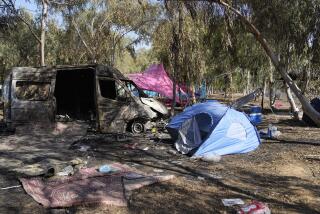The Torture Network : Ever More Sophisticated Worldwide, It Is Leaving a Trail of Shattered Lives in Cities Like Los Angeles
Torture is a thriving business. Perhaps not a growth industry but certainly not on the wane, according to the organizations that monitor and combat it. Amnesty International reports increasingly scientific methods of torture are practiced in at least 98 countries as unacknowledged government policy--primarily for the purpose of discouraging dissent.
Torture victims are legion, and many survivors, it turns out, are living within the large immigrant populations of Southern California.
âI think thereâs no doubt there are more torture victims in the Southern California area than anywhere else in the United States or Canada,â said Los Angeles psychiatrist Harvey Weintraub. âPlaces like refugee camps in Pakistan and Thailand probably have more, but I think itâs safe to say there are more refugees, and therefore more torture victims, in Los Angeles than in any other city in the Western world.â
Weintraub is president of the Walter Briehl Human Rights Foundation, a local group that has recently begun treating victims here through individual referrals and hopes eventually to establish a victimsâ center similar to the Rehabilitation Center for Torture Victims in Copenhagen.
To his aid has come the medical director and founder of the Danish center, which was the first of its kind in the world. Dr. Inge Kemp Genefke, the Danish neurologist who pioneered the treatment of torture victims, was in Los Angeles last week to raise funds for her center while supporting Weintraubâs. But what she really brought was a wealth of information about a world of horror.
Genefke, who received the Briehl Foundationâs human rights award earlier this year, is a quiet, calm woman. She speaks with a growing sense of intensity and urgency as she describes torture victims, whom she prefers to call survivors (âthey are the strong ones,â) and their ordeal. Her experience has done little to alter either her horror of torture or her compassion and respect for the victims.
âWhat is torture?â She rhetorically repeated the question directed to her. âIt is to try to destroy a person, to kill you while you remain alive in the body. Today, torture is a science,â she said.
Sleep deprivation, mock executions, forced witnessing of othersâ physical torture or execution, even of the torture of oneâs own children or family--âItâs sophisticated,â she said. âThey make you exhausted by physical means. They humiliate you. They isolate you so that your best friend becomes an ant and you grieve if it dies. They destroy your identity. Then they can send you out there, humiliated, and you can spread the fear.â
Not that physical torture has been abandoned, she added. She repeats a gruesome litany of abuses and the aftermath she has seen--beatings, sexual attacks, electrical shocks, broken bones, severed limbs, blindings, punctured eardrums, lost teeth, scars, suffocation and near drownings--usually in foul liquids containing human wastes.
The physical torture is purposeful, however, and its end is the psychological destruction she repeatedly describes as âby far the worst of the after-effects.â Among those after-effects: identity problems, anxiety, sleeplessness, nightmares, headaches, sexual dysfunction, inability to concentrate, loss of self-esteem and self-respect, survivor guilt, humiliation.
âItâs bloody much the same the world over. Fifteen years ago there were differences, but not now. We are behind the torturers. They cannot surprise us. If someone tells me of a new method in one country, in a month or so I start hearing victims from other countries describe the same thing.â Later, Weintraub described it as âa weird network of torturers around the world.â
Genefkeâs compassion for the victims is almost matched by her repugnance of the practitioners, and to describe them she seems to fortify herself with a certain amount of sarcasm:âThey take young men, usually from rural areas, and subject them to harsh treatment, beatings, humiliations--like making love to a chair while others watch. Then they tell them they are the best soldiers and take them to an area where the first phase of torture is beginning--the beatings. If they can stand that, then they are ready for the next stage. It seems to work. They are well trained, paid well, and, when a prisoner finally breaks down, they get a holiday or a reward. Just like we have our human rights awards, they have theirs. That is the system.â
Her special scorn, however, is reserved for doctors and psychologists who abet the torturers. âThey canât do it today without their cooperation,â she said, referring to the scientific methods, and the necessity to stop short of death. Her organization, and others such as the Briehl Foundation, are âgoing after the doctor torturers,â she said, collecting documentation, issuing professional warnings, seeking to raise the consciousness of medical students and other health personnel regarding the abuses.
Genefke, 49, started her work about 15 years ago, when as a board member of Amnesty International she was approached for help during Amnestyâs campaign for the abolition of torture. To her surprise, there was little medical evidence of the after-effects of torture--just a vague assumption that once released, people would resume their normal lives. She went with a team of doctors to Greece to systematically interview and examine victims from the recently deposed dictatorship. Later, Chilean victims were brought to Denmark; an international conference was held; individual referrals were made. Then in 1979, the Copenhagen University hospital agreed to take some victims.
From the start, it was an awesome experience. For example, she said, the word nightmare took on a new dimension after just one night when she saw how soaked the victimsâ bed linens were--âThe nightmares were that extreme.â
Today the center, supported by public and private funds, has a permanent staff of 30--doctors, nurses, psychologists, physiotherapists, social workers--and offers multidisciplinary treatment to about 100 victims and their families yearly. It also trains Danish and foreign personnel, conducts research on the nature and consequence of torture, conducts seminars on such topics such as children and torture, and runs an international documentation center. Its staff help set up similar centers and programs around the world--sometimes in the face of extreme danger, such as a clandestine training session they conducted in the Philippines during the Marcos regime.
The treatment, she said, which typically lasts from 6 to 12 months--depending on the length of the torture and how long ago it was--combines psychotherapy and physiotherapy.
One important aspect of treatment involves making victims understand âthe impossible choice,â she said. Often while imprisoned, they are confronted with what they perceive to be a choice, she said, such as signing a statement accusing other prisoners of some crime or not signing and, as a result, seeing their 8-year-old sister brought in and raped before them. In treatment, they are presented with such a hypothetical example, and asked to make one choice or the other and describe their feelings. No matter the decision, the feelings of guilt and dismay are the same.
âStrong, Courageous Peopleâ
âBlame, shame and guilt should be on the shoulders of the torturers, not these people. These are strong, courageous people. They were working for something--religious, social, political--and then they were taken to prison. Itâs terrible they should feel this way.â
In all aspects of treatment, care has to be taken to avoid reminders, she said. Taking blood samples, undergoing electrocardiograms, being touched, entering a tiled medical lab, seeing X-ray machines or instruments can be terrifying. Thus the non-institutional, homey nature of the center, she said. The victims have had enough of institutions.
Survivors tell of such intense suffering that they longed for death or physical torture, she said. âAt least physical torture would show them they were still alive. Or, if they have been in isolation, maybe kept hooded, they long to be physically tortured because at least they would see other people (their torturers.)
âIt is so perverted,â she said with a shudder. âYou have no words for it really. It is in another world. It is far beyond tears.â
She added, âThe one good thing is that today there is concern.â Torture is nowhere near being eliminated, but at least many people now care. Not only are there an increasing number of professional organizations forming around the world, there is a United Nations resolution against torture that has been ratified to date by 29 countries--meaning torturers fleeing to such countries can be brought to trial.
Roster of Professionals
In Los Angeles, Weintraub said, humanitarian organizations are referring survivors for treatment to the Briehl Foundation and it is beginning to develop a roster of volunteer mental health care professionals. It has helped train staff at one service center where Central American victims were turning up, and is developing a four- to six-hour educational program on torture that Weintraub hopes can be taken into professional schools.
Ninety percent of those who go through treatment do get well and can lead normal productive lives, Genefke added. They will never be the same, but they will be able to put the torture in the past and go on with their lives.
âThere is the moment,â she said, when the survivor says, âI feel like myself again. Now I am happy. My nightmares become dreams.â
Genefke means that literally. Torture victims âtell of nightmares where they are running, running, running, and then the torturer catches up with them and the torture starts.â
After months of treatment, she said, there comes a day when they describe dreams to her where they are ârunning, running, running, and all of a sudden they can fly.â
She smiled triumphantly at the thought, throwing her arms upward, in flight for a moment herself. âWhen they tell me that, I know we will soon finish.â
More to Read
Sign up for Essential California
The most important California stories and recommendations in your inbox every morning.
You may occasionally receive promotional content from the Los Angeles Times.










